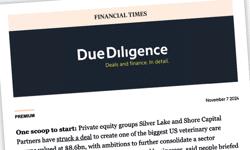This year's Convergence Survey, the sixth in a series of reports published by Olswang since 2005, asks, 'Does It Add Up?' and identifies digital trends and predictions for the future. The findings are based upon a combination of interviews conducted with over 30 senior executives across the technology, media and telecoms sectors and an online YouGov survey with more than 2,000 participating adult consumers.
In terms of device ownership, the survey results show that iPad owners also show higher than average ownership of dedicated e-book readers despite the overlapping functionality of these larger-screened devices: 15% of our iPad owners also own an e-book reader (compared to 6% of the overall base). Similarly, 9% of e-book reader owners (compared to 3% of the whole base) also have an iPad. While part of this is down to early adopters, it is clear that the two categories of device fighting for market share in the digital publishing world can co-exist. Publishers also want this to happen – it gives them greater opportunities to defend themselves against the power of gatekeepers.
When you look to content consumption, 60% of respondents do not expect to access digital newspapers at all in 2011. Also of particular note (in the context of paywalls) are the 22% of respondents who expect to access digital newspapers but without paying anything in return. This means that only around 17% of our base appear likely to spend anything on digital newspaper content in 2011 (with similar results for e-books and digital magazines).
However, there is clearly a different attitude when you look at the behaviour of people who already own tablets and e-book readers - some 48% of iPad users intend to purchase digital newspapers in 2011 and 26% of e-book reader owners also intend to buy digital newspaper content.
John Enser, Media Partner at Olswang LLP said: “Newspapers are still struggling to find a sustainable digital business model. We spoke to senior advertising industry executives and the stark truth is that there isn’t enough advertising money in the world to fund the number of content sites who are looking for advertising to support their content. Bearing in mind the boom in take-up of iPads and other tablet devices, these survey results are more encouraging than we have seen previously for the erection of paywalls.”
From talking with Publishers during the survey, it is clear that they understand that their relationships with consumers need to evolve and that, in this regard, they are in competition with the gatekeepers and intermediaries.
Matt Phillips, Technology Partner at Olswang LLP comments: “Given the controversial terms recently imposed by Apple for subscription-based content services, it can be expected that publishers will respond in three ways – first, they will increasingly look beyond Apple’s iOS platform for compelling pay distribution platforms – so are pleased to see Kindles being given away with phones at Carphone Warehouse. Second, they are already seeking regulatory interventions against Apple and third, they will no doubt continue to look for new ways to ‘game’ Apple’s rules.”
In addition to talking to over 30 senior executives from a range of industries affected by convergence, Olswang commissioned YouGov to conduct a piece of quantitative consumer research. Total sample size was 2021 adults. Fieldwork was undertaken between 4 February 2011 and 7 February 2011. The survey was carried out online. The figures have been weighted and are representative of all GB adults (aged 18+).
In the survey, a digital newspaper was defined so as to include newspaper websites, but to exclude other news websites such as BBC News.
Key findings also include:
• Tablets – tablets, especially the iPad, are a catalyst for change in many areas of consumer behaviour. Of particular interest is the rising use of tablets as second or companion screen devices alongside TV, which are set to revolutionize the way we watch television with 29% of iPad owners likely to pay 99p for an app that would allow them to play along with a TV gameshow. Social media will play a big role as it promotes the buzz of watching something "now" and socialising with others watching at around the same time;
• Music – To explore consumer attitudes to a broad range of music related activity, the survey asked respondents to imagine that they had a voucher that had to be spent on music-related activities, and to tell us which of a range of activities they would spend it on first. 18- to 24-year-olds showed a significant preference for live events (34%) over CDs and downloads (11%) with 32% of female respondents choosing live performances compared to 22% of males;
• Publishing the report looks at the consumption of on-line content showing that although 60% of our respondents do not expect to access digital newspapers in 2011. However, there is clearly a different attitude when you look at the behaviour of people who already own tablets and e-book readers - some 48% of iPad users intend to purchase digital newspapers in 2011 and 26% of e-book reader owners also intend to buy digital newspaper content;
• The continued importance of scheduled TV - much non-linear viewing on PVRs and VOD platforms will continue to be tied to traditional scheduled viewing as TV schedules form viewing decisions and catch-up television services continue to encourage this behaviour.
• Movies – film distributors are worried that the Netflix model doesn't deliver enough revenue to them. 3D will remain powerful in the cinemas, but there is limited evidence to support its widespread adoption at a consumer level.










